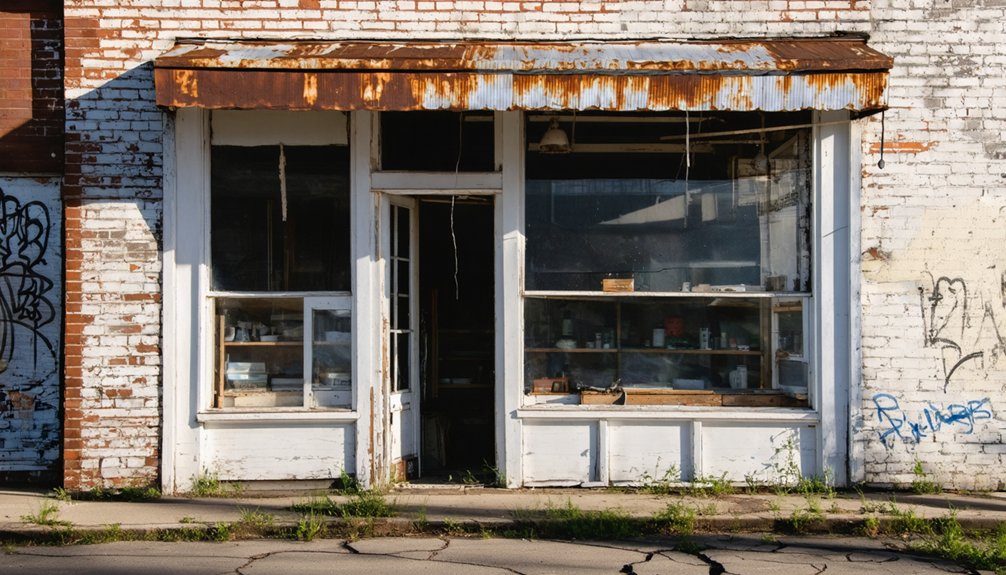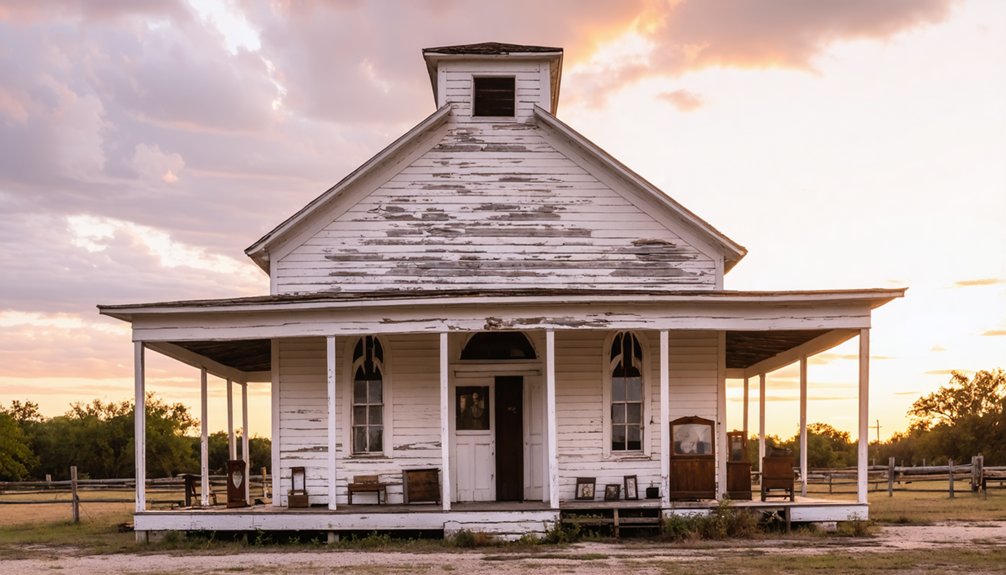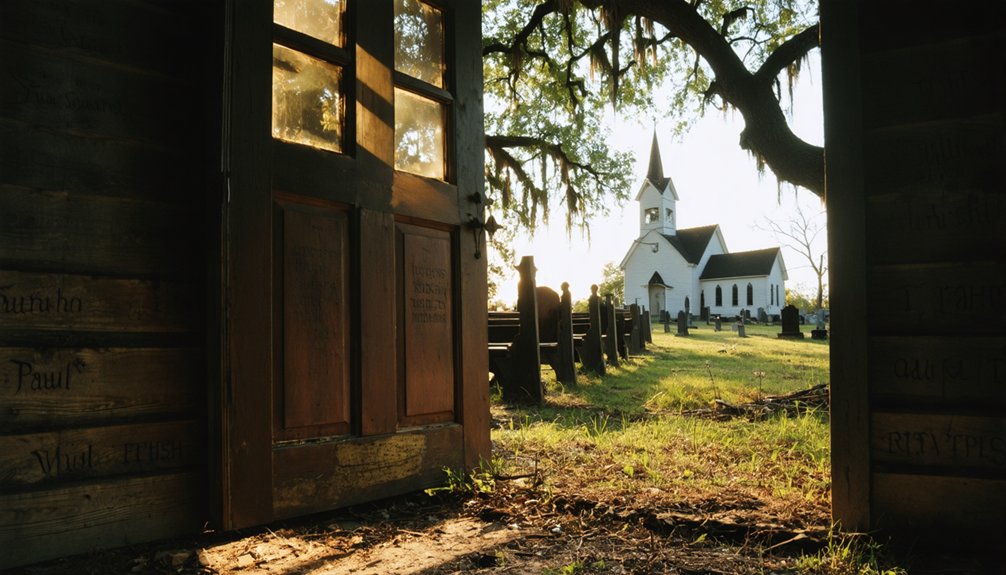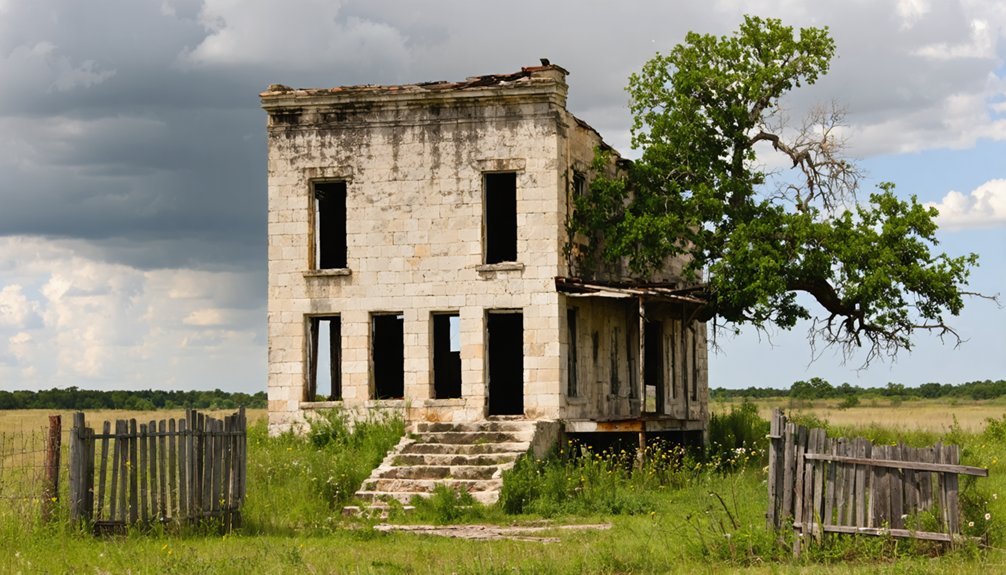You’ll discover The Grove, Texas, as a remarkably preserved ghost town between Temple and Gatesville. Founded in 1859 as Morrison Grove, it flourished into a bustling agricultural center with 400 residents by 1900, boasting general stores, a mill, and cotton gin. The town’s decline began in the 1940s when infrastructure changes claimed farmland for Fort Hood and Lake Belton. In 1972, Moody Anderson transformed the abandoned site into a living museum, where each historic structure tells a unique story.
Key Takeaways
- The Grove, Texas, established in 1859, declined from a thriving 400-person town to a ghost town by the 1940s.
- Major infrastructure changes, including Fort Hood and Lake Belton construction, forced residents to relocate and abandon their properties.
- The town’s decline accelerated when Highway 35 rerouting cut off access, and issues with the central well disrupted daily life.
- Moody Anderson purchased The Grove in 1972, transforming it into a living museum by preserving and restoring historic buildings.
- Original structures, including the Cocklebur Saloon, general store, and doctor’s office, remain preserved as museum pieces today.
Origins and Early Settlement (1859-1900)
A grove of towering live oak trees marked the spot where The Grove, Texas would take root in 1859.
Originally known as Morrison Grove, this natural landmark attracted settlers who recognized the area’s agricultural potential.
Settlement patterns evolved as pioneers established homes and farms around the majestic oaks, which served as a central gathering place for the growing community. The town experienced steady growth through the late 1800s, reaching a peak of 400 residents by the turn of the century. By the late 1860s, the thriving settlement boasted two general stores, along with a mill and cotton gin.
The Rise to Prosperity
You’ll find that The Grove’s transformation from a small settlement into a thriving commercial center began in the 1860s, as the population steadily grew from 150 to 400 residents by 1900.
The town’s economic foundation rested on agricultural exports, including cotton, grain, and hides, which attracted merchants and craftsmen to establish diverse businesses in the area. The prosperity continued until new transportation routes like modern highways bypassed the town.
The heart of the community centered around essential establishments including a post office and saloon, serving both the practical and social needs of residents.
Economic Growth 1860-1900
Following its establishment in 1859, The Grove experienced remarkable economic growth through the latter half of the 19th century.
You’d have found agricultural innovation taking shape with the addition of a mill and cotton gin by the late 1860s, alongside two bustling general stores.
The town’s strategic location near transportation advancements, particularly the railroad, enabled local farmers to ship cotton, hides, and grain efficiently to distant markets.
Diverse Commercial Establishments
The Grove’s commercial landscape flourished in the mid-1880s with three general stores and two groceries serving its growing population.
You’d find local businesses thriving as farmers shipped cotton, hides, and grain to distant markets. At the heart of town, a blacksmith shop, saloon, and community well provided essential services to residents and travelers alike. W.J. Dube built an impressive two-story brick building that became a local landmark in 1917. The town reached its peak with a population of 400 during its most prosperous years.
The general store wasn’t just a shop – it transformed into a multipurpose hub where you could handle banking, collect mail, or see the doctor.
Churches and Religious Heritage
When you explore The Grove’s religious heritage, you’ll find a diverse spiritual foundation built by Baptist, Methodist, Disciples, Presbyterian, and Lutheran congregations in the mid-1800s.
The arrival of Wendish settlers around 1870 particularly strengthened the Lutheran presence, leading to the establishment of St. Paul Lutheran Church in 1883 and its accompanying school in 1908.
While many churches faded as The Grove declined, St. Paul Lutheran Church’s 1908 building remains active today, serving as a lasting symbol to the town’s rich religious history.
Lutheran Heritage Lives On
During the 1870s, Wendish (Sorbian) Lutheran settlers arrived in The Grove, Texas, establishing a vibrant religious community that would shape the town’s identity for generations.
By 1883, they’d built their first Lutheran church, which quickly became a cornerstone for both worship and community gatherings. Like many early congregations, they used a one-room schoolhouse for both religious services and education. As the congregation grew, they constructed a larger church in 1908, along with a Lutheran school that would educate local children until 1962. Local services were conducted by dedicated ministers like Rev. J.A. Reuter, who served as the first official pastor from 1914 to 1919.
Lutheran traditions flourished in The Grove, helping the town reach its peak population of 150 residents in the mid-1880s. The church preserved European customs while serving both Wendish and non-Wendish residents alike.
Though The Grove’s population declined after the 1940s, the Lutheran legacy endures through preserved buildings and the cultural heritage maintained by local residents.
Multiple Faiths Built Community
Beyond the Lutheran presence, multiple faith traditions enriched The Grove’s cultural landscape throughout the mid-1800s. The town’s churches served as essential community centers, hosting everything from educational programs to social gatherings that fostered interfaith dialogue among settlers.
You’ll find these religious institutions weren’t just places of worship – they became pillars of social cohesion and cultural preservation.
Each denomination contributed unique communal rituals to The Grove’s identity, while their buildings and cemeteries stand today as representations of the town’s diverse spiritual heritage.
Church leaders often guided both religious and civic affairs, demonstrating how faith communities shaped the settlement’s development. This interdenominational cooperation proved significant in sustaining The Grove through its peak years and subsequent decline.
Education Through the Decades
Although The Grove’s early years focused primarily on commerce and religion, its educational development became a cornerstone of community life by the turn of the 20th century.
You’ll find that despite early educational challenges, the town established a robust two-teacher public school serving sixty students by 1904. The community’s engagement deepened when they opened a Lutheran school in 1908, creating a dual education system that served multiple generations. The town continues to draw visitors throughout the year, maintaining its historical significance even after its decline.
You can trace the schools’ steady presence through the 1930s and early 1940s when The Grove’s population held at 150.
However, progress brought change, and by 1948, improved transportation led to the public school’s closure. The Lutheran school persisted until 1962, but eventually, both institutions succumbed to the town’s declining population, marking the end of The Grove’s educational era.
Economic Life and Commerce

The Grove’s rise as a commercial hub began shortly after its 1859 establishment, when early settlers recognized the area’s agricultural potential. By the 1860s, you’d find two general stores, a mill, and a gin serving the growing farming community.
The town reached its commercial peak in the late 1800s, boasting three general stores, two groceries, and a population of 400 residents who shipped cotton, hides, and grain.
The town’s agricultural decline began with several major blows: State Highway 36’s bypass, Fort Hood’s establishment, and the Belton Dam’s construction in 1953. These changes forced farmer relocations and reduced available farmland.
The Decline and Transformation
While The Grove flourished into the early 1900s, a series of devastating changes in the 1940s marked the beginning of its decline.
You’ll find that infrastructure impact hit hard when Fort Hood’s construction claimed 250,000 acres, and Lake Belton took another 50,000, forcing many residents to relocate.
The town’s refusal to cap its central well led to Highway 35’s rerouting, cutting off crucial commerce and triggering severe population decline. The closure of the post office late 1940s symbolized the town’s fading prominence.
Preservation Efforts and Museum Status

When you visit The Grove today, you’ll see the results of Moody Anderson’s ambitious 1972 vision to transform this small Texas town into a living museum.
Anderson’s preservation work included moving the historic Cocklebur Saloon from Round Rock and converting original structures like Dube’s general store, the bank, and blacksmith shop into museum spaces.
His dedication to historical authenticity showed in his careful restoration of buildings and his vast collection of period-appropriate artifacts, from covered wagons to antique farm implements.
Historical Building Restoration
Since purchasing the downtown area in 1972, Moody Anderson spearheaded extensive restoration efforts that transformed The Grove into a living museum of Texas history.
You’ll find several meticulously restored structures, including the relocated Cocklebur Saloon from Round Rock, which now stands proudly next to the blacksmith shop. The former general store has been converted into a fascinating museum housing period-specific antiques and artifacts.
While Anderson’s vision brought new life to these historical buildings, restoration challenges emerged after his auction.
Today, you can still explore many intact structures, though they’re not always open to the public. The preservation team continues to use traditional architectural techniques to maintain the buildings’ authentic character, ensuring that The Grove’s rich history remains tangible for future generations.
Moody Anderson’s Museum Vision
After purchasing The Grove in 1972, Moody Anderson transformed the declining ghost town into a vibrant living museum that showcased early 20th-century rural life.
His museum innovation shone through as he converted town buildings into multi-purpose venues while maintaining historical authenticity. You’d find meticulously curated displays of period-specific artifacts, from household goods to veterinary items, arranged in themed areas like the dentist’s office and blacksmith shop.
Anderson’s commitment to Americana preservation extended beyond static displays. He’d rent artifacts to film productions, including “Lonesome Dove” and “True Grit,” making The Grove’s collection an active part of cultural preservation.
While the museum initially welcomed visitors with regular tours, public access gradually decreased after Anderson put the property up for auction in the mid-2010s, transferring ownership to descendants of the original proprietors.
Notable Structures and Architecture
The heart of The Grove’s historic district centers around a communal well dug in 1872, with key original structures radiating outward in a traditional frontier town layout.
You’ll find the most prominent building, The Grove house, showcasing a unique blend of Greek Revival and French Creole architectural features, built in 1861 using cypress beams and wooden lap siding.
The historical significance of the town’s design is evident in its preserved commercial structures, including an interconnected general store, bank, and doctor’s office.
The relocated Cocklebur Saloon stands adjacent to the blacksmith shop, maintaining authentic spatial relationships.
Most buildings remain in their original positions, though locked and boarded, emphasizing preservation over modern adaptation.
The wooden construction style reflects typical mid-19th-century Texas frontier craftsmanship.
Cultural Impact of Wendish Settlers

While architectural remnants tell one story of The Grove’s past, Wendish settlers brought a distinctive cultural tapestry that shaped the town’s identity.
These Lutheran immigrants, who first arrived in Texas in 1854, established a presence in The Grove as they dispersed from their initial settlement in Serbin. You’ll find their influence reflected in the town’s religious conservatism and strong work ethic.
Like other Wendish settlements in Texas, The Grove’s Wendish families initially strove to preserve their unique language and customs.
However, proximity to German communities led to rapid cultural assimilation. By the early 20th century, most families had shifted from speaking Wendish to German, and later English.
Despite this transformation, Wendish descendants maintained their Lutheran faith and traditional values, contributing to The Grove’s character until its decline.
Historical Legacy and Modern Significance
Established in 1859 amid a picturesque grove of live oak trees, The Grove’s historical legacy spans from its modest beginnings as Morrison Grove to its evolution into a significant cultural touchstone.
Through historical preservation efforts, particularly Moody Anderson’s 1972 restoration, you’ll discover a remarkable representation of Central Texas pioneer life. The town’s transformation from a thriving agricultural community to a Smithsonian-recognized museum town showcases its enduring cultural significance.
- Experience authentic 1880s architecture, including the iconic St. Paul Lutheran Church built in 1908
- Marvel at the town’s journey from bustling commerce center to carefully preserved historical site
- Witness how the community adapted to challenges, from Fort Hood’s expansion to Belton Dam’s construction
Frequently Asked Questions
Is the Grove Haunted by Any Reported Ghost Sightings?
You won’t find documented ghost stories or official paranormal investigations here. Despite its ghost town status, The Grove’s charm comes from its history and cultural significance rather than supernatural encounters.
Can Visitors Stay Overnight in the Grove’s Historic Buildings?
Behind the weathered walls and creaking floorboards, you can’t stay overnight at The Grove. The historic preservation guidelines restrict overnight accommodations, limiting your experience to guided one-hour tours of this protected landmark.
What Happened to the Original Families Who Lived There?
You’ll find most original settlers and their family legacies scattered after the 1940s, when Fort Hood’s establishment and Lake Belton’s construction forced them to relocate from their ancestral farmlands.
Are There Guided Tours Available of the Grove?
You can join guided exploration tours on Saturdays at 2 PM and Sundays at 11 AM for $10. You’ll learn about local history, but can’t bring kids under 10 or pets.
Does the Grove Host Any Annual Festivals or Events?
While jamborees once drew crowds to the Cocklebur Saloon, you won’t find annual celebrations there today. The last known local tradition was a musical performance by Chuck Allen before the 2010 antique auction.
References
- https://talesfromthewayside.com/blog-1/2016/10/12/the-grove-tx
- https://www.tshaonline.org/handbook/entries/grove-tx
- https://www.polkaworks.org/the-grove-texas-documentary
- https://www.youtube.com/watch?v=-7XyPu5jkIk
- https://www.youtube.com/watch?v=M43wsfqmk-s
- https://www.mysanantonio.com/news/local/article/Texas-ghost-town-featured-in-new-documentary-5623452.php
- https://en.wikipedia.org/wiki/The_Grove
- https://www.texasescapes.com/TexasGhostTowns/TheGroveTexas.htm
- http://texasghosttowns.blogspot.com/2012/02/grove-coryell-county-august-2010-photos.html
- https://artistforlandscapes.wordpress.com/2012/03/05/the-grove-texas-a-museum-ghost-town/



